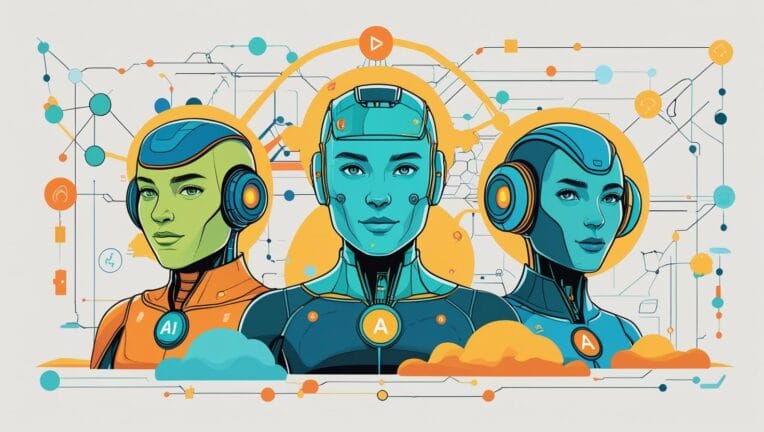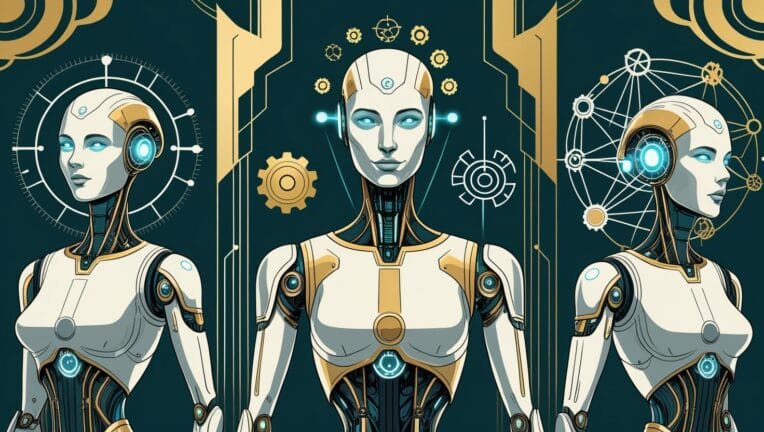
Table of Contents
Introduction
The world of artificial intelligence has evolved dramatically over the past decade, moving beyond simple algorithms to more sophisticated systems. At the forefront of this evolution is the AI agent – a technology that’s reshaping how we think about automation and intelligent systems. But what exactly is an AI agent, and how does it differ from other AI technologies we’re familiar with?
An AI agent is an autonomous software system designed to reason, plan, and execute complex tasks based on high-level goals. Unlike traditional AI systems that operate on simple request-response patterns, AI agents represent a significant step toward truly autonomous systems capable of managing intricate workflows without constant human supervision. They’re designed to perceive their environment, make decisions, and take actions to achieve specific objectives – much like a human assistant would, but with the processing power and consistency of a machine.
As businesses and organizations look for ways to streamline operations and enhance productivity, understanding AI agents has become increasingly important. This article explores what makes these systems unique, how they work, and the impact they’re having across various industries.
What Are AI Agents ? Definition and Core Concepts
At its core, an AI agent is a software entity that can operate independently to accomplish tasks on behalf of users or organizations. Understanding what makes an AI agent different from other AI systems requires examining its core components and capabilities.
The fundamental architecture of an AI agent includes several key elements that work together to create an autonomous system:
- Brain Component (LLM): This serves as the central decision-making unit, typically powered by a Large Language Model. It coordinates access to necessary data and manages the overall behavior of the agent.
- Memory Systems: AI agents utilize both short-term memory for current context and long-term memory for historical interactions. This dual memory approach enhances decision-making capabilities over time, allowing the agent to learn from past experiences.
- Tool Integration: Most advanced AI agents can connect with external tools and APIs, enabling them to perform actions in the real world or digital environments.
What truly sets AI agents apart is their ability to operate with minimal human intervention. While chatbots and other AI systems typically require explicit instructions for each task, AI agents can take a high-level goal and break it down into the necessary steps to achieve it. This autonomous operation represents a significant advancement in artificial intelligence technology.
Key Components That Make Up an AI Agent
The core AI agent components include a brain component (usually an LLM), memory systems, and integration capabilities. Each of these AI agent components plays a crucial role in enabling autonomous decision-making and task execution.
Beyond the basic architecture, AI agents possess several key capabilities that enable their autonomous functioning:
- Reasoning: The ability to analyze data, identify patterns, and draw logical conclusions.
- Acting: Taking concrete actions based on decisions, often through integration with external systems.
- Observing: Gathering information from the environment to inform decision-making.
- Planning: Creating strategies to achieve goals, often involving multiple steps.
- Collaborating: Working effectively with humans or other AI systems.
- Self-refining: Learning from experiences to improve performance over time.
Modern AI agent capabilities include reasoning, acting, observing, planning, collaborating, and self-refining. These AI agent capabilities allow them to handle complex workflows that would otherwise require significant human intervention.
Types of AI Agents : Classification and Examples
AI agents come in various forms, each designed for specific purposes and with different levels of complexity. Understanding these classifications helps in selecting the right type of agent for particular applications.
Interaction-Based Classification
AI agents can be categorized based on how they interact with users and systems:
- Interactive Partners (Surface Agents)
- Engage directly with users
- Handle customer service inquiries
- Provide educational support
- Assist with healthcare questions
- Autonomous Background Processes
- Operate behind the scenes
- Automate data processing
- Manage workflows without direct user interaction
- Monitor systems for anomalies
Capability-Based Classification
Another way to categorize AI agents is based on their reasoning and decision-making abilities:
- Simple Reflex Agents
- Operate based on predefined rules
- Process data immediately without memory
- Example: Basic password reset systems
- Model-Based Reflex Agents
- Maintain an internal model of the world
- Make decisions based on patterns
- Example: Smart thermostats that learn preferences
- Goal-Based Agents
- Possess complex reasoning capabilities
- Evaluate multiple approaches to achieve goals
- Suitable for natural language processing tasks
- Utility-Based Agents
- Optimize decisions for maximum benefit
- Focus on user satisfaction
- Example: Flight booking systems that balance cost and convenience
- Learning Agents
- Continuously improve through experience
- Adapt to changing environments
- Example: Recommendation systems that refine suggestions over time
Each type has its strengths and ideal use cases, making the selection of the right agent type crucial for successful implementation.
AI Agent vs Chatbot: Understanding the Key Differences
When comparing an AI agent vs chatbot, the key difference lies in the agent’s ability to make autonomous decisions and take actions. While both technologies involve artificial intelligence, they serve different purposes and have distinct capabilities.
Chatbots are primarily designed for conversation. They excel at answering questions, providing information, and guiding users through predefined processes. However, they typically operate within narrow parameters and follow scripted responses.
Unlike a simple chatbot, an AI agent vs chatbot comparison reveals that agents can handle complex, multi-step tasks without constant human guidance. Here are the key distinctions:
- Autonomy: Chatbots generally respond to specific prompts, while AI agents can take initiative and make decisions independently.
- Complexity: Chatbots handle straightforward interactions, whereas agents can manage complex workflows involving multiple systems.
- Learning Capability: Advanced AI agents continuously learn and improve from interactions, while many chatbots have limited learning abilities.
- Integration: AI agents typically connect with multiple tools and systems to complete tasks, while chatbots often operate within a single platform.
- Goal Orientation: Agents work toward achieving specific objectives, while chatbots focus on responding to immediate queries.
Understanding these differences is crucial for organizations deciding which technology best suits their needs. For simple customer inquiries, a chatbot might be sufficient. For complex processes requiring judgment and multi-step actions, an AI agent would be more appropriate.

Real-World AI Agent Applications Across Industries
AI agent applications span across healthcare, manufacturing, e-commerce, and financial services industries. These intelligent systems are transforming operations and creating new possibilities in various sectors.
Healthcare
In healthcare, AI agents are revolutionizing patient care and administrative processes:
- Diagnostic workflow automation, reducing the time from test to diagnosis
- Patient care optimization through monitoring and alerts
- Appointment scheduling and follow-up management
- Medical record analysis for identifying patterns and risks
Studies have shown significant improvements in diagnostic accuracy when AI agents assist healthcare professionals, leading to better patient outcomes.
Manufacturing
The manufacturing sector has embraced AI agents for:
- Predictive maintenance that anticipates equipment failures
- Quality control automation that identifies defects
- Supply chain optimization to reduce costs and delays
- Production scheduling to maximize efficiency
These applications have resulted in an average 30% reduction in downtime, translating to substantial cost savings.
E-commerce
One of the most promising AI agent applications is in customer service, where they can reduce support tickets by up to 65%. In e-commerce, AI agents handle:
- Personalized product recommendations
- Inventory and supply chain management
- Customer service automation
- Fraud detection and prevention
Major online retailers attribute up to 35% of their revenue to AI-driven recommendation systems, highlighting the significant impact of this technology.
Financial Services
An AI sales agent can transform customer interactions by providing personalized recommendations and handling routine inquiries. In financial services, AI agents are used for:
- Fraud detection through real-time transaction analysis
- Risk assessment for loans and insurance
- Investment portfolio management
- Regulatory compliance monitoring
Financial institutions have reported a 70% reduction in fraudulent activities after implementing AI agent systems, protecting both the companies and their customers.

How to Build an AI Agent
Learning how to build an AI agent requires understanding both the technical architecture and the specific use case requirements. As more organizations recognize the value of AI agents, there’s growing interest in developing custom solutions tailored to specific needs.
The process of how to build an AI agent typically involves selecting the right LLM, designing memory systems, and implementing reasoning capabilities. Here’s a simplified overview of the development process:
- Define the Purpose: Clearly identify what tasks the agent will perform and what goals it should achieve.
- Select the Foundation: Choose an appropriate Large Language Model (LLM) that will serve as the brain of the agent.
- Design the Memory Architecture: Implement both short-term and long-term memory systems to enable contextual understanding and learning.
- Integrate Tools and APIs: Connect the agent with necessary external systems to enable actions and data access.
- Implement Reasoning Frameworks: Develop the logic that will guide the agent’s decision-making process.
- Train and Test: Provide examples and scenarios to help the agent learn, then thoroughly test its performance.
- Deploy and Monitor: Launch the agent in a controlled environment and continuously monitor its performance.
The n8n ai agent represents a specific implementation that focuses on workflow automation and integration capabilities. Developers can leverage the n8n ai agent to create custom automation solutions for various business processes.
While building an AI agent requires technical expertise, the availability of development frameworks and pre-trained models has made the process more accessible than ever before.
Current Limitations and Challenges of AI Agent Technology
Despite their impressive capabilities, AI agents face several significant challenges and limitations that must be addressed for wider adoption:
Technical Challenges
- Reliability Issues: The LLMs that power many AI agents can sometimes produce inaccurate information or make flawed decisions, particularly in novel situations.
- Transparency Problems: Many AI agents operate as “black boxes,” making it difficult to understand how they reach specific conclusions.
- Integration Complexity: Connecting AI agents with existing systems and ensuring smooth data flow remains challenging for many organizations.
- Scalability Concerns: Some AI agent architectures struggle to maintain performance as the scope of tasks or volume of data increases.
Ethical Considerations
The development and deployment of AI agents also raise important ethical questions:
- Deceptive Practices: When AI agents mimic human interaction too closely, users may not realize they’re communicating with a machine, raising concerns about transparency.
- Privacy and Security: AI agents often require access to sensitive data, creating potential privacy risks if not properly secured.
- Accountability: When an AI agent makes a mistake, questions arise about who bears responsibility—the developer, the deploying organization, or the agent itself.
- Job Displacement: As AI agents automate more complex tasks, concerns about workforce impact have become increasingly prominent.
Addressing these challenges requires a combination of technical innovation, thoughtful regulation, and organizational best practices. The most successful implementations of AI agent technology carefully balance autonomy with appropriate human oversight.
The Future of AI Agent Development and Adoption
The market for AI agent technology is projected to grow from $5.1 billion in 2024 to $47.1 billion by 2030, reflecting the increasing recognition of its value across industries. This rapid growth is driven by several emerging trends:
Enhanced Autonomy
Future AI agents will likely demonstrate greater independence in task execution, transitioning from tools that assist humans to integral components of organizational systems. This evolution will enable them to handle increasingly complex workflows with minimal supervision.
Advanced Reasoning Capabilities
Ongoing research in AI is focused on improving agents’ problem-solving abilities and decision-making processes. These advancements will allow agents to tackle more nuanced challenges and operate effectively in ambiguous situations.
Seamless Integration
The next generation of AI agents will feature improved integration capabilities, allowing them to work seamlessly with a wider range of systems and tools. This will expand their utility and make implementation less resource-intensive.
Multi-Agent Collaboration
Perhaps most intriguingly, we’re beginning to see the emergence of systems where multiple AI agents collaborate to solve problems. These “agent teams” can distribute tasks based on specialized capabilities, potentially revolutionizing how complex projects are managed.
Companies implementing an AI sales agent have reported significant improvements in lead qualification and customer engagement. As these technologies mature, we can expect to see AI agents becoming standard components of business operations across virtually all industries.
Conclusion
AI agents represent a significant evolution in artificial intelligence technology, moving beyond simple automation to truly autonomous systems capable of complex reasoning and decision-making. From healthcare to manufacturing, financial services to e-commerce, these intelligent systems are transforming how organizations operate and creating new possibilities for efficiency and innovation.
While challenges remain—particularly around reliability, transparency, and ethical considerations—the trajectory of AI agent development points toward increasingly sophisticated and capable systems. Organizations that understand and thoughtfully implement this technology stand to gain significant competitive advantages in the coming years.
As AI agents continue to evolve, they’ll likely become more integrated into our daily lives, both professionally and personally. Understanding what they are, how they work, and their potential impact is the first step in preparing for this AI-enhanced future.
Whether you’re a business leader exploring automation opportunities, a developer interested in building AI systems, or simply someone curious about emerging technologies, AI agents represent one of the most fascinating and potentially transformative developments in modern computing.
